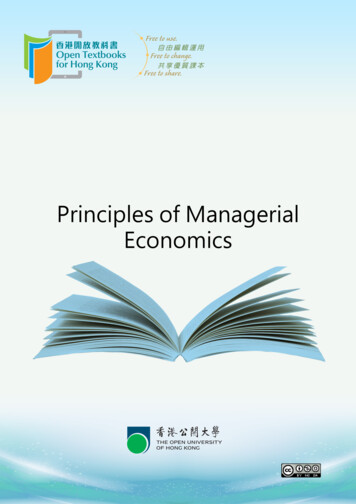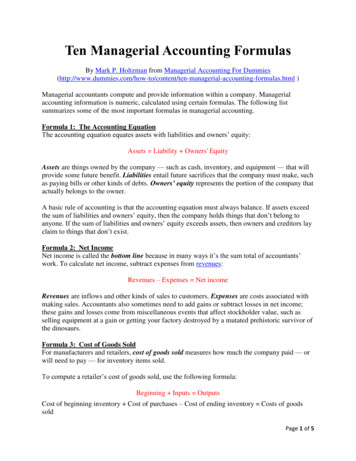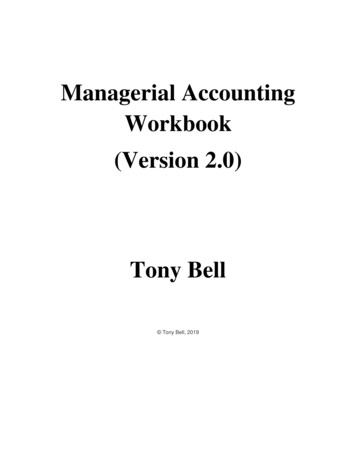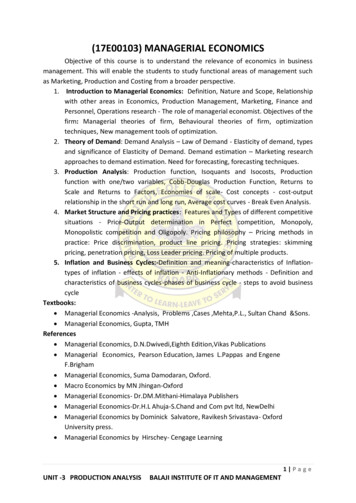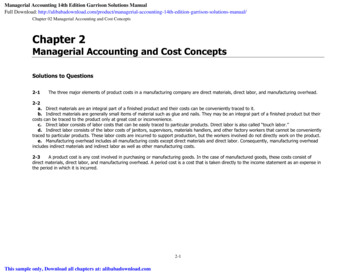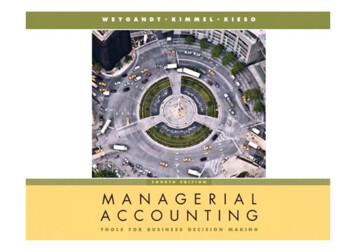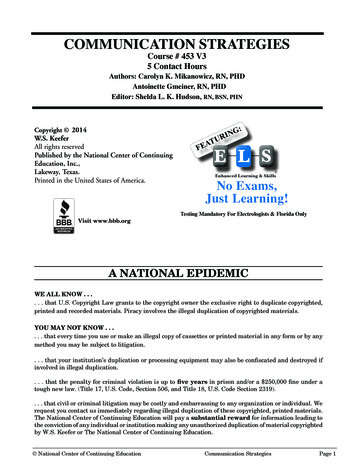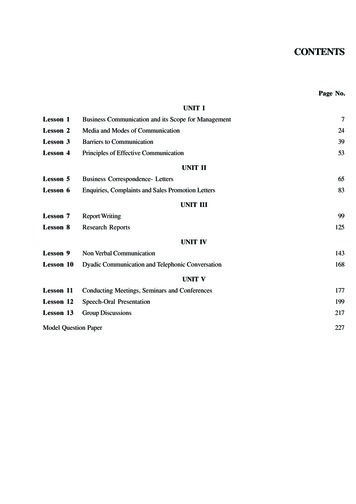
Transcription
CONTENTSPage No.UNIT ILesson 1Business Communication and its Scope for Management7Lesson 2Media and Modes of Communication24Lesson 3Barriers to Communication39Lesson 4Principles of Effective Communication53UNIT IILesson 5Business Correspondence- Letters65Lesson 6Enquiries, Complaints and Sales Promotion Letters83UNIT IIILesson 7Report WritingLesson 8Research Reports99125UNIT IVLesson 9Non Verbal Communication143Lesson 10Dyadic Communication and Telephonic Conversation168UNIT VLesson 11Conducting Meetings, Seminars and Conferences177Lesson 12Speech-Oral Presentation199Lesson 13Group Discussions217Model Question Paper227
COMPENSATION MANAGEMENTSYLLABUSUNIT ICommunication - Meaning and significance for management - Types of communication- Media-Barriers to communication - Principles of effective communication.UNIT IICorrespondence - Norms for Business letters - Letter for different kinds of situations Personalized standard letters , enquiries , customers complaints , collection letters - salespromotion letters.UNIT IIIReport writing - Structure of reports - long & short reports - formal & informal reports- writing research reports, technical reports - norms for including exhibits & appendices.UNIT IVNon-verbal communication - personal appearance, posture - body language - use ofcharts , diagrams & tables - audio visual aids for communication - Dyadic Communication:face to face communication - telephonic conversation.UNIT VConducting Meetings : Procedure - preparing Agenda , minutes and resolutions - conductingseminars and conferences:- Procedure of Regulating speech - evaluating oral presentation- Group Discussion: Drafting speech.
UNIT I
LESSON1BUSINESS COMMUNICATION ANDITS SCOPE FOR MANAGEMENTCONTENTS1.0Aims and Objectives1.1 Introduction1.2 Defining Communication1.3 Nature of Communication1.4 Classification of Communication1.5 Objectives/Purpose of Communication1.6 Scope of Communication1.7 Importance and Functions of Communication1.8 Evaluation of Communication Effectiveness1.9 Organizational Communication1.9.1 Information to be Communicated in an Organisation1.9.2 Importance of Communication in Management1.10 Let us Sum up1.11 Lesson End Activities1.12 Keywords1.13 Questions for Discussion1.14 Suggested Readings1.0 AIMS AND OBJECTIVESAfter studying this lesson, you should be able to: Understand the meaning and definition of business communication. Be able to know the objectives of communication Know the relevance of communication in an organisation and in management Understand the functions and importance of communication Know the scope of communication
8Executive Communication1.1 INTRODUCTIONCommunication means to create a common understanding. Communication is an importantaspect of human behavior. It stands for natural activity of all human beings to conveyopinions, feelings, information, and ideas to others through words (written or spoken),body language, or signs. Communication is an integral part of life. From birth till deathevery living being is communicating in his or her own way, be it birds, animals, trees orhuman beings.The word Business stands for any economic activity undertaken with a view toearn profit. The communication undertaken in the process of this activity is termed asbusiness communication. From the very inception of the idea of the Business, to run theday to day activities of the Business, communication is involved. It includes oral, written,formal, informal, upward, downward, lateral, diagonal, inward outwards as well as nonverbal communication.Communication is the most vital ingredient of an organization. In fact, an organizationcannot be conceived of without communication. An organization is a group of personsconstituted to achieve certain specific objectives. The achievement of these objectiveslargely depends upon a proper co-ordination and integration of human effort in anorganization. The people working in an organization are interrelated; their activities arealso interrelated because all activities are performed only to achieve the organizationalobjectives. Co-ordination and integration of various human activities are possible only ifthere is an effective system of communication in the organization which provides forexchange of information and sharing of various ideas. The more effective the system ofcommunication, the better is the relation between workers and the management.It is communication which gives life to the organization; so, it is rightly known as the lifeblood of an organization1.2 DEFINING COMMUNICATIONThe term communication has been derived from the Latin word ‘communis’ that means‘common’ and thus, if a person effects communication, he establishes a common groundof understanding. Literally, communication means to inform, to tell, to show, or to spreadinformation. Thus, it may be interpreted as an interchange of thought or information tobring about understanding and confidence for good industrial relations. It brings aboutunity of purpose, interest, and efforts in an organisation.Definitions: There are a number of definitions of the term communication. A few ofthem are being reproduced below:“Communication is the sum of all things, one person does when he wants to createunderstanding in the minds of another. It involves a systematic and continuous processof telling, listening and understanding.”– Allen LouisCommunication has been defined “As the transfer of information from one person toanother whether or not it elicits confidence.”– Koontz and O’ Donell“Communication is an exchange of facts, ideas, opinions or emotions by two or morepersons.”– George Terry
Communication is defined as “the process of passing information and understandingfrom one person to another, it is essentially a bridge of meaning between people. Byusing the bridge of meaning a person can safely cross the river of misunderstanding.”– Keith DavisEffective communication is “purposive interchange, resulting in workable understandingand agreement between the sender and receiver of a message”.– George Vardman“Communication is interchange of thoughts, opinions, or information, by speech, writing,or signs”.– Robert AndersonCommunication is the process by which information is passed between individuals and/or organizations by means of previously agreed symbols.– Peter LittleCommunication is any behaviour that results in an exchange of meaning.– The American Management AssociationCommunication may be broadly defined as the process of meaningful interaction amonghuman beings. More specifically, it is the process by which meanings are perceived andunderstandings are reached among human beings.– D.E. McFarland1.3 NATURE OF COMMUNICATIONThe analysis of the above definitions implies that communication has the followingcharacteristics, which define the nature of Communication1.It is process: The term process has been defined as an identifiable flow ofinterrelated events moving over time towards some goal or an end. Accordingly,communication is a process in which there are some identifiable inter-related eventswhich starts with the sender. Then it moves by encoding messages, through somechannel till the receiver receives the massage and ends with the feedback.2.It is inevitable: Communication is essential physically, socially and psychologically.If an individual is provided all physical comforts but is not allowed to read, write,speak and listen, he will become mentally retarded.3.Meaning Based: communication is meaning-based. As has been very succinctlysaid by a specialist, “The most immediate need for communication is to be able torefer to things in the real world, that is, to be able to name things, states, events,attributes, using words”. In addition, we must be able to link words together so asto make meaningful sentences and language. Hence, there is a need to be clearheaded about what we want to say.4.Communication is intentional as well as unintentional: While somecommunication is intended, that is, it is purposely done, much of the communicationmay be unintentional, that is, we might convey, in many ways, even what we don’twish to communicate.5.Communication is systematic: Every component of Communication is affectedby the other. The one who sends the message, the message itself as well as thereceiver of the message; all are interrelated and affected by each other.9Business Communication andits Scope for Management
10Executive Communication6.A two-way traffic: A significant aspect of communication is involvement of atleasttwo people, i.e., a sender and a receiver. In fact, one person cannot communicateto himself. A receiver is must to complete the communication act. There is nocommunication, until the massage sent by the sender is being received by thereceiver. A personnel director may send hundreds of memos and warning letters toemployee, but communication is not complete unless it is received and read bythem. Since communication is an exchange of views, opinions, directions etc., it isa two-way traffic. The “two way” can be understood in many ways. It is not justthe sender is involved in communication, but the receiver, is also equally involved inthe process. In another way, Communication is both ways, upward as well asdownward, in an organization. Messages, directives, opinions, etc., are sent to lowerlevels in the hierarchy of management. Likewise, grievances, complaints, opinionsfeelings, points of view etc., are communicated upward along the line, i.e., fromworkers (lower level) to management (higher level). George Terry has rightlyremarked, “Simply talking or writing, without regard to the recipients’response, is conducive to misunderstanding.” Thus, communication should beboth ways.7.Communication is a social process: Human being is a social animal. He cannotlive in isolation. Communication is a process which helps the human being to interactand socialize. Hence, it is a social process.8.Dynamic Process: Dynamic means “ever changing”. Communication is not aconstant, one time event. It is a dynamic process, which is changing all the time.9.Continuous Process: Communication is a continuous process. More often thannot, it is repeated to achieve the desired results. It is an ongoing process, in whichone interaction is followed by the other.10. Communication is both interaction and transaction: The participants ofcommunication exchange ideas and information and also influence each other inthe process. They share and exchange both thoughts and meanings.11.It is spiraling process: Communication between the receiver and the sender usuallydoes not start as the same level or grow at the same rate. It is due to difference atabilities of the sender as well as the receiver. Moreover, noise and time have animpact on it. As a result. Communication takes a spiral shape before it is completedand reaches the receiver the same level and space12. It is contextual: Communication happens with reference to a context. The samewords would mean different things if they are said in different contexts. Hence,meaning may differ in different situations.13. Needs proper understanding: There may be numerous media of communicationbut the main purpose of conveying the message is to create a proper understandingof the message in the mind of the other party. For this purpose, it should be clearlyand concisely worded.14. Leads achievement of the organizational objective: Effective communicationdoes this by creating the sense of object orientation in the organization.15. Dispels misunderstanding: In this sense, it provides clear understanding betweenpersons and thus builds a bridge of camaraderie among people.16. It has four specific skills: Communication has four specific skills. They are reading,writing, speaking and listening. Their brief sketch is shown in the following Exhibit.
Exhibit: Communication SkillsSkillsActivenessRelated toSender/Receiver ralReceiver15. It is all pervasive: Irrespective of the type and size of the organization,communication is inevitable. It is important at all levels. It exists everywhere in anorganization. With communication, it is possible to delegate authority, to coordinateactivities, and to take managerial decisions.16. It shares thoughts and ideas, which produce response: Thoughts and ideas,which do not produce response, do not come under the Preview of communication.17. It is the lifeblood of the business: No business organization and no civilized societycan exist, survive and grow without the existence of an effective communicationnetwork. Through communication, people working in an organization get activatedand involved in performing variety of roles for achieving organizational goals. Variousmode of communication are used for people outside the organization to know theexistence, products, profit and progress of the organization.Check Your Progress 1Fill in the blanks:1.Commumication is derived from Latin word 2.The four specific skills of Communication are , , , .3.Communication is the of business.1.4 CLASSIFICATION OF COMMUNICATIONWe classify communication according to the number of persons (receivers) to whom themessage is addressed:1.Intrapersonal Communication: It is talking to oneself in one’s own mind. Examplesare soliloquies or asides in dramatic works.2.Interpersonal Communication: It is the exchange of messages between twopersons. For example, a conversation, dialogue, or an interview in which two personsinteract (others may also be present as audience). An author communicatesinterpersonally with his reader, who is always present as a silent audience in theauthor’s mind while he writes. A letter too is an example of interpersonalcommunication between the writer and the person to whom it is written.3.Group Communication: It can be among small or large groups, like an organization,club or classroom, in which all individuals retain their individual identity.4.Mass Communication: It occurs when the message is sent to large groups ofpeople, for example, by newspaper, radio, or television. In this process, each personbecomes a faceless individual with almost no opportunity for personal response orfeedback.11Business Communication andits Scope for Management
12Executive CommunicationCommunication can also be classified on the basis of the medium employed:1.Verbal Communication: It means communicating with words, written or spoken.Verbal communication consists of speaking, listening, writing, reading, and thinking.It may further be classified as Oral or Written Communication.2.Non-verbal communication: It includes using of pictures, signs, gestures, andfacial expressions for exchanging information between persons. It is done throughsign language, action language, or object language. Non-verbal communication flowsthrough all acts of speaking or writing. It is a wordless message conveyed throughgestures (sign), movements (action language), and object language (pictures/clothes)and so on. Further non-verbal communication can be identified by personal space(proxemics), sense of smell (olfactics) and time (chronemics).3.Meta Communication: Here the speaker’s choice of words unintentionallycommunicates something more than what the actual words state. For example, aflattering remark like “I’ve never seen you so smartly dressed” could also meanthat the regular attire of the listener needed improvement.4.Formal Communication: A formal channel of communication can be defined asa means of communication that is formally controlled by managers or peopleoccupying positions in an organization. The communication flows through formalchannels, that is, officially recognized positions along the line in the organization.This ensures that the information flows orderly, timely, and accurately. Anyinformation, decision, memo, reminder etc. will follow this path.5.Informal Communication: Side by side with the formal channel of communicationevery organization has an equally effective channel of communication that is theinformal channel. It is not officially sanctioned, and quite often it is even discouragedor looked down upon. But, then, it is very much there, and has been given the name‘grapevine’ precisely because it runs in all directions-horizontal, vertical, diagonal.As the management experts put it, “it flows around water coolers, downhallways, through lunch rooms, and wherever people get together in groups”.6.Downward Communication: The Communication that flows from Top to Bottomis known as downward communication. Any organization has an inbuilt hierarchicalsystem, and in that, in the first instance, communication invariably flows downwards.7.Upward Communication: The Communication that flows from bottom to top,which is from lower hierarchical level to higher level, is called UpwardCommunication. The main function of upward communication is to supplyinformation to the upper levels about what is happening at the lower levels. It is justthe reverse of the previous dimension8.Lateral Communication: When communication takes place between two or morepersons who are subordinates working under the same person, or those who areworking on the same level, it is called lateral or horizontal communication. A goodexample of this kind of communication is that between functional managers. It isnecessary for the reviewing of the activities assigned to various subordinates havingidentical positions9.Diagonal Communication: Diagonal or Crosswise communication includes flowof information among persons at different levels who have no direct reportingrelationships. As an example, the Communication between the Training Supervisorand Marketing Manager, regarding the Training of a few employees of MarketingDepartment, is Diagonal Communication. This kind of communication is used tospeed up information flow, to improve understanding, and to coordinate efforts forthe achievement of organizational objectives.
Check Your Progress 2Define the following:1.Mass Communication2.Verbal Communication 1.5 OBJECTIVES/PURPOSE OF COMMUNICATIONAn objective is something that we want to attain or accomplish by our efforts; it is thepurpose with which we undertake an activity. When we speak or write to our friends,we may not have a specific purpose, except to keep in touch, to be friendly; when wechat with a group of friends, we simply want to socialize, be friendly, or express ourselves.But in an official or business situation, when we speak, listen or write to customers, or toour subordinates or our superiors, we have a specific purpose or objective; we want toaccomplish something. Communication could have many objectives depending on thecontext and persons involved. Communication within a family, in a classroom, in a theatre,in a seminar, in a boardroom and in the organsation has different objectives. The objectivesdepend upon the purpose to be achieved.The objectives of business communication would include the following: To inform: This is the foremost objective of communication. Information is power.The information needs within and outside the organization can be met throughcommunication To persuade: Businesses work through persuation. It is important to persuadeemployees to work efficiently, to persuade customers to buy our product and so on.The objective of communication may be to persuade. To educate: To disseminate knowledge and develop skills and attitudes amongpeople working in the organization may be another objective of communication. To train: Communication is an integral part of any training programme. Training isrequired to achieve proficiency in specific skills. Instruction, demonstration, practiceand discussion during training require communication as an integral part. To motivate: High level of morale and motivation are a must to ensure high levelsof productivity and efficiency on a sustainable basis. Communication provides ameans to keep motivation levels high. To integrate: Large business organizations have different business units,departments and territorial divisions, pursuing different targets. Communicationprovides the means for an integrated approach in pursuing organizational goals. To relate: Good business relations are a must for the continued success of anybusiness organsiation. Communication provides the means for building and nurturingmutually beneficial relationships.13Business Communication andits Scope for Management
14Executive Communication To entertain: Whatever be the nature of business, there is always a time forentertainment. Communication facilitates social bonding and brings lighter momentsthat help in entertainment and relieving tension.The objectives of communication are dynamic and ever-changing. Some of the commonobjectives of official communication are to get or give information, to ask for or giveinstructions or advice or suggestions, to make requests, to persuade other people toagree with us. Sometimes, we communicate with the intention of complaining, or warning;but unfortunately, we do this angrily and get into arguments. If we learn to complain andwarn in an acceptable and constructive manner, our serious intention can be conveyedquite effectively without damaging relationships. In order to caution, counsel, clarify,apprise, evaluate, reprimand, organize and numerous such objectives, we make use ofcommunication.1.6 SCOPE OF COMMUNICATIONCommunication has unlimited scope. The scope of Communication can be understoodunder two headings:1.External Dimension2.Internal DimensionExternal Dimension: External dimension regarding communication have a bigger arena.It includes building relations with external agencies and stakeholders. Effectivecommunication can establish a healthy external organizational climate in which there istrust, cooperation, collaboration, innovation and commitment. Self involvement of peoplein various activities is inculcated to create vibrant and congenial atmosphere . Likewise,depending upon how an organization looks after its advertisements, publicity and publicrelations function, public image and goodwill of the organization is created through effectivecommunicationInternal Dimension: A lot of communication takes place within the organization. In anorganization, starting from formulating corporate vision, mission policy objectives, takinggoals to their implementation, communication plays a significant role. For formulatingpolicies, top management needs to obtain information and views of the middle and lowerlevel management through various forms. Especially for the appropriate implementationof the top management policies and plans, it is only communication which facilitatesproper understanding of the policies in the right spirit. Public relations, as a managementfunction, solely depend on right communication. There are different functions to beperformed by various functional departments to keep the organization running. Withineach department and across different departments, functional heads have to communicateto their subordinates by giving job-related instructions, suggestions, advice and orders.For obtaining and giving cooperation to other departments, exchange of information playsa key role.When we look at each functional department, the scope of communication further becomesclear. For example, in the case of human resources department, the HR manager needsto take care of communication to avoid grievance, dissatisfaction, and industrial unrest inthe entire organization. Communication skill is essential for manager to design rightadvertisement copies, conducting effective interviews, arranging better trainingprogrammers etc.
In addition to external and internal dimensions, the scope of communication may belooked into as follows: Includes oral and non-verbal communication. Interpersonal, intrapersonal and mass communication. Covers only human communication. Covers four skills- reading, writing, speaking and listening.Check Your Progress 3What do you understand by the term external dimension of communication? 1.7 IMPORTANCE AND FUNCTIONSOF COMMUNICATIONCommunication plays a vital role in every walk of life. According to Luthans, someestimates of the extent of its use to go up to about three –fourths of an active humanbeing’s life, and even higher proportions of a typical manager’s time. The world is changingfast and with it, every organization is becoming more and more sophisticated. So,communication has first of all to be given due recognition as an integral part of processchange. Whenever a change in the direction of technology, structures or objectives takesplace, it becomes easier with the help of communication.The importance of communication can be judged from the functions performed by it.Following are the important functions of communication:1.Information Sharing: The main purpose of communication is to transmitinformation for a source to target individuals or groups. Various type of informationis transmitted in the organisation: policies and rules, and changes and developmentin the organisation etc. There may be need for fast diffusion of some information inthe organisation, e.g., special rewards and awards given, settlements with the union,and major changes in the organisation.2.Feedback: There is a need to give feedback to the employees on their achievements,to the department on their performance, and to the higher management on thefulfillment of goals; and, difficulties encountered in the communication of feedbackhelps in taking corrective measures and making necessary adjustments, and itmotivates people in developing challenging and realistic plans.3.Influence: information is power. One purpose of communication is to influencepeople. The manager communicates to create a good environment, right attitudes,and congenial working relationship. All these are examples of influencing.4.Problem-solving: In many cases communications aim to solving problems.Communication between the management and the unions on some issues(negotiation) is aimed at finding solutions for a problem and to evolve a consensus.5.Assists in decision-making: The most important function of every manager isdecision-making. In order to make accurate and appropriate decision, a managerneeds to obtain information available in various channels of communication. Here15Business Communication andits Scope for Management
16Executive Communicationthe way decision is communicated will have an impact upon the outcomes of theorganization in terms of cooperation and support of the people to achieveorganizational goals. For arriving at a decision several kinds of communication areneeded, e. g., exchange of information, views, and available alternative etc.,communication helps a great deal in decision –making.6.Facilitating change: The effectiveness of a change introduced in an organisationdepends to a large extent on the clarity and spontaneity of the communication.Communication between the managers and employees helps in recognising thedifficulties in the planned change, and in taking corrective action.7.Group building: Communication helps in building relationships. If communicationbreaks down the group may disintegrate. Communication provides the necessarylubrication for the proper functioning of a group.8.Gate keeping: Communication helps to build linkages of the organisation with theoutside world. The organisation can use its environment to increase its effectiveness.9.Conveying the right message: The main object of communication is to conveythe right message to the right person, i.e., to the person for whom it is meant. Themessage conveyed should be well understood and accepted by the receiver in theright perspective. In other words, it should carry the same meaning which has beenconveyed so that it may be translated in to action effectively.10. Helps in Co-ordination of Effort: Communication is an effective tool forco-coordinating the activities of different persons engaged in running a business.Co-ordination without communication is a remote possibility. In organizations, thereexist a lot of differences, which are many a times formally created by an organizationthrough departments, divisions, delegation, decentralization, authority and power.Through various effective communication mechanisms like letters, circulars,meetings conferences, telephone, cellular phones etc., these differences areminimised and activities are properly coordinated to achieve organizational goals.The individuals or groups come to know what others are doing and what is expectedfrom only through communication.11.Good industrial Relations: communication develops good industrial relations as itconveys the feelings, ideas, opinions and viewpoints of one party two the otherparties. The two parties –the management and the subordinates come closer throughcommunication. They understand each other and dispel any misunderstanding. Thus,it promotes cooperation and good industrial relations.12. Development of managerial skills: Communication helps managers to understandhuman behaviour at work. Communication of facts, ideas, opinions, information,feelings etc., add value to the knowledge of managers about various happenings, inthe organization and behaviour of people. Thus, communication is a process oflearning.13. Ensuring Effectiveness of policies: The organisation formulates policies andprogrammes to guide the work force. This should be conveyed properly to thosewho are really responsible for the execution of work to achieve the organisationobjectives. Only effective communication can translate the policies in to action.Effectiveness of the policies can be judged from the success which surely dependsupon an effective communication system.14. Motivating Peo
Page No. UNIT I Lesson 1 Business Communication and its Scope for Management 7 Lesson 2 Media and Modes of Communication 24 Lesson 3 Barriers to Communication 39 Lesson 4 Principles of Effective Communication 53 UNIT II Lesson 5 Business Correspondence- Letters 65 Lesson 6 Enquiries, Complaints

